FASHIONABLE TRADITIONS
By Li Xiaoyang



Shan Zhen, a fashion blogger in her 20s with about 1 million followers on the Chinese social media platform Weibo, recently posted, “Li-Ning sneakers are comfortable and have a great design. I love China Chic!” In the comments section, many users echoed her view and posted their own pictures of the sneakers.
After years of sluggish growth due to rising competition and old-fashioned products, LiNing, a sportswear brand founded by former Olympic gymnastics champion Li Ning in 1990, has revived its past glory which began as a sponsor of the 1990 Beijing Asian Games, and again become a well-received fashion brand among young consumers, riding on the trend of China Chic.
Since 2018, China Chic, or guochao, has become all the rage, transforming into a new sales magnet. Once referred to as Chinese streetwear, it has developed into a concept involving emerging domestic brands and designs inspired by Chinese culture.
While international fashion brands keep entering the Chinese market, an increasing number of domestic consumers, especially the young, have developed a great interest in China Chic products, which make them feel connected to the Chinese culture. According to data from Xiaohongshu, the Chinese equivalent of Instagram for lifestyle sharing, posts related to these products grew by 116 percent year on year in the first half of 2019, with over 5 million users sharing their views. A report released in April 2019 by Suning, a Chinese retailer, showed that people born in the 1990s accounted for 35.64 percent of the domestic consumers of China Chic products.
Cosmetics, clothes and shoes are the top three China Chic product categories, according to Fanli.com, a Chinese online discount shopping site.
“Since Chinese consumers demands have been upgrading, the emergence of China Chic brands is in line with their expectations of showcasing personality, and suggests their rising confidence in domestic products,”Cui Lili, Executive Director of the Institute of E-Commerce at the Shanghai University of Finance and Economics, told Beijing Review.
Robust rise
Along with the revival of China Chic, many Chinese companies have made room for growth by rebranding and mixing tradition and innovation in their products, with booming ecommerce platforms contributing to sales growth.
Li-Ning suffered losses of about 3 billion yuan ($433 million) from 2012 to 2014, closing over 1,800 stores in 2013. Introducing new designs with Chinese elements, it made its New York Fashion Week debut in February 2018, attracting as much attention as more formal wear. As models unveiled the new designs, which included hoodies with the Chinese characters for “China Li-Ning,” and sneakers inspired by the traditional Chinese philosophy Taoism, more domestic consumers flocked to the brand.
“The new White Rabbit products are popular because they remind domestic buyers of their childhood,” Dong Yang, one of the designers of the clothes, told Chinanews.com.
As Chinese elements become highlights of the fashion and cosmetic industry, the demand for other creative products has also grown.
The Palace Museum, the imperial palace in the Ming (1368-1644) and Qing (1644-1911) dynasties and one of the major tourist destinations in Beijing, has rolled out products related to its collections since 2018. Its online stores, which sell derivative products, have over 10 million followers. In December 2018, online buyers snapped up more than 100,000 Palace Museum-themed lipsticks in four days during a promotional event on Tmall.


As hanfu, the traditional attire of the Han ethnic group, has become increasingly popular among young people in recent years, a promising market has developed.
According to data from state broadcaster China Central Television, the hanfu market had more than 2 million consumers in September 2019, with a total value of 1.09 billion yuan ($158 million). In the same period, sales of hanfu garments increased by 146 percent year on year.
Developing an interest in hanfu about 14 years ago, Li Xiaoxuan, a staff member at the Beijing Hanfu Association, is glad to see a booming market of the genre, where she can buy a variety of traditional-style apparel, since she had to get her clothes tailor-made.
“About three fifths of my clothes are hanfu. Now I spend over 2,000 yuan ($289) on new purchases every year,” she told Beijing Review, adding that she dresses in hanfu on many occasions, including shopping and traveling.
According to Li, the development of the hanfu market has driven up many related industries such as ancient-style shoe and ornament production, and boosted sales of traditional handicrafts.
Controlling the chaos
As more brands flood into the China Chic market, industry observers have warned that those trying to make quick money by riding the wave will face difficulties.

